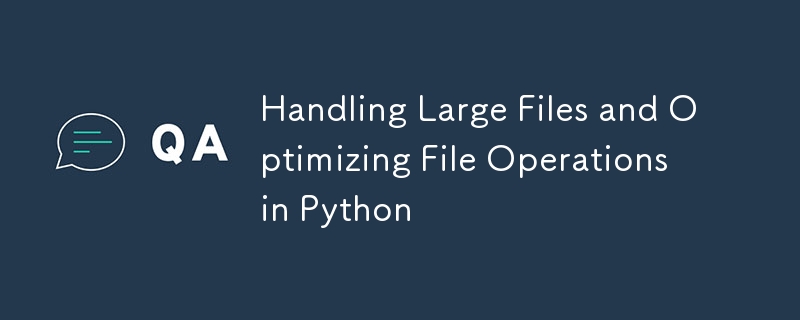Python 中处理大文件并优化文件操作

在这个博客系列中,我们将探索如何在 Python 中处理文件,从基础开始,逐步进展到更高级的技术。
在本系列结束时,您将对 Python 中的文件操作有深入的了解,使您能够有效地管理和操作文件中存储的数据。
该系列将由五篇文章组成,每篇文章都建立在上一篇文章的知识之上:
- Python 文件处理简介:读写文件
- 使用不同的文件模式和文件类型
- (这篇文章)在 Python 中处理大文件和文件操作
- 使用上下文管理器和异常处理来实现稳健的文件操作
- 高级文件操作:使用 CSV、JSON 和二进制文件
随着 Python 项目的增长,您可能会处理无法轻松同时加载到内存中的大文件。
高效处理大文件对于性能至关重要,尤其是在处理可能达到数 GB 的数据处理任务、日志文件或数据集时。
在这篇博文中,我们将探索在 Python 中读取、写入和处理大文件的策略,确保您的应用程序保持响应速度和高效。
大文件的挑战
处理大文件时,您可能会遇到几个挑战:
- 内存使用:将大文件完全加载到内存中会消耗大量资源,导致性能下降,甚至导致程序崩溃。
- 性能:如果不进行优化,对大文件的操作可能会很慢,从而导致处理时间增加。
- 可扩展性:随着文件大小的增长,对可扩展解决方案的需求对于维持应用程序效率变得更加重要。
为了应对这些挑战,您需要能够在不影响性能或稳定性的情况下处理大文件的策略。
高效读取大文件
处理大文件的最佳方法之一是以较小的块读取它们,而不是将整个文件加载到内存中。
Python 提供了多种技术来实现此目的。
使用循环逐行读取文件
逐行读取文件是处理大型文本文件最节省内存的方法之一。
这种方法会在读取时处理每一行,使您可以处理几乎任何大小的文件。
# Open the file in read mode
with open('large_file.txt', 'r') as file:
# Read and process the file line by line
for line in file:
# Process the line (e.g., print, store, or analyze)
print(line.strip())
在此示例中,我们使用 for 循环逐行读取文件。
strip() 方法删除任何前导或尾随空格,包括换行符。
此方法非常适合处理日志文件或数据集,其中每行代表一个单独的记录。
读取固定大小的块
在某些情况下,您可能希望以固定大小的块读取文件,而不是逐行读取。
这在处理二进制文件或需要处理数据块中的文件时非常有用。
# Define the chunk size
chunk_size = 1024 # 1 KB
# Open the file in read mode
with open('large_file.txt', 'r') as file:
# Read the file in chunks
while True:
chunk = file.read(chunk_size)
if not chunk:
break
# Process the chunk (e.g., print or store)
print(chunk)
在此示例中,我们指定 1 KB 的块大小并以该大小的块读取文件。
while 循环继续读取,直到没有更多数据可供读取(块为空)。
此方法对于处理大型二进制文件或需要使用特定字节范围时特别有用。
高效写入大文件
就像读取一样,高效写入大文件对于性能至关重要。
分块或批量写入数据可以防止内存问题并提高操作速度。
以块的形式写入数据
将大量数据写入文件时,分块写入比逐行写入更有效,尤其是在处理二进制数据或生成大型文本文件时。
data = ["Line 1\n", "Line 2\n", "Line 3\n"] * 1000000 # Example large data
# Open the file in write mode
with open('large_output_file.txt', 'w') as file:
for i in range(0, len(data), 1000):
# Write 1000 lines at a time
file.writelines(data[i:i+1000])
在此示例中,我们生成一个大的行列表,并将它们以 1000 行为一组批量写入到文件中。
这种方法比单独编写每一行更快、更节省内存。
优化文件操作
除了高效地读写数据之外,您还可以使用其他几种优化技术来更有效地处理大文件。
使用seek() 和tell() 进行文件导航
Python 的eek() 和tell() 函数允许您在文件中导航,而无需读取整个内容。
这对于跳到大文件的特定部分或从某个点恢复操作特别有用。
- seek(offset, whence): Moves the file cursor to a specific position. The offset is the number of bytes to move, and whence determines the reference point (beginning, current position, or end).
- tell(): Returns the current position of the file cursor.
Example: Navigating a File with seek() and tell()# Open the file in read mode
with open('large_file.txt', 'r') as file:
# Move the cursor 100 bytes from the start of the file
file.seek(100)
# Read and print the next line
line = file.readline()
print(line)
# Get the current cursor position
position = file.tell()
print(f"Current position: {position}")
In this example, we move the cursor 100 bytes into the file using seek() and then read the next line.
The tell() function returns the cursor's current position, allowing you to track where you are in the file.
Using memoryview for Large Binary Files
For handling large binary files, Python’s memoryview object allows you to work with slices of a binary file without loading the entire file into memory.
This is particularly useful when you need to modify or analyze large binary files.
Example: Using memoryview with Binary Files# Open a binary file in read mode
with open('large_binary_file.bin', 'rb') as file:
# Read the entire file into a bytes object
data = file.read()
# Create a memoryview object
mem_view = memoryview(data)
# Access a slice of the binary data
slice_data = mem_view[0:100]
# Process the slice (e.g., analyze or modify)
print(slice_data)
In this example, we read a binary file into a bytes object and create a memoryview object to access a specific slice of the data.
This allows you to work with large files more efficiently by minimizing memory usage.
Conclusion
Handling large files in Python doesn’t have to be a daunting task.
By reading and writing files in chunks, optimizing file navigation with seek() and tell(), and using tools like memoryview, you can efficiently manage even the largest files without running into performance issues.
In the next post, we’ll discuss how to make your file operations more robust by using context managers and exception handling.
These techniques will help ensure that your file-handling code is both efficient and reliable, even in the face of unexpected errors.
以上是Python 中处理大文件并优化文件操作的详细内容。更多信息请关注PHP中文网其他相关文章!

热AI工具

Undresser.AI Undress
人工智能驱动的应用程序,用于创建逼真的裸体照片

AI Clothes Remover
用于从照片中去除衣服的在线人工智能工具。

Undress AI Tool
免费脱衣服图片

Clothoff.io
AI脱衣机

Video Face Swap
使用我们完全免费的人工智能换脸工具轻松在任何视频中换脸!

热门文章

热工具

记事本++7.3.1
好用且免费的代码编辑器

SublimeText3汉化版
中文版,非常好用

禅工作室 13.0.1
功能强大的PHP集成开发环境

Dreamweaver CS6
视觉化网页开发工具

SublimeText3 Mac版
神级代码编辑软件(SublimeText3)
 Python与C:学习曲线和易用性
Apr 19, 2025 am 12:20 AM
Python与C:学习曲线和易用性
Apr 19, 2025 am 12:20 AM
Python更易学且易用,C 则更强大但复杂。1.Python语法简洁,适合初学者,动态类型和自动内存管理使其易用,但可能导致运行时错误。2.C 提供低级控制和高级特性,适合高性能应用,但学习门槛高,需手动管理内存和类型安全。
 Python和时间:充分利用您的学习时间
Apr 14, 2025 am 12:02 AM
Python和时间:充分利用您的学习时间
Apr 14, 2025 am 12:02 AM
要在有限的时间内最大化学习Python的效率,可以使用Python的datetime、time和schedule模块。1.datetime模块用于记录和规划学习时间。2.time模块帮助设置学习和休息时间。3.schedule模块自动化安排每周学习任务。
 Python vs.C:探索性能和效率
Apr 18, 2025 am 12:20 AM
Python vs.C:探索性能和效率
Apr 18, 2025 am 12:20 AM
Python在开发效率上优于C ,但C 在执行性能上更高。1.Python的简洁语法和丰富库提高开发效率。2.C 的编译型特性和硬件控制提升执行性能。选择时需根据项目需求权衡开发速度与执行效率。
 学习Python:2小时的每日学习是否足够?
Apr 18, 2025 am 12:22 AM
学习Python:2小时的每日学习是否足够?
Apr 18, 2025 am 12:22 AM
每天学习Python两个小时是否足够?这取决于你的目标和学习方法。1)制定清晰的学习计划,2)选择合适的学习资源和方法,3)动手实践和复习巩固,可以在这段时间内逐步掌握Python的基本知识和高级功能。
 Python vs. C:了解关键差异
Apr 21, 2025 am 12:18 AM
Python vs. C:了解关键差异
Apr 21, 2025 am 12:18 AM
Python和C 各有优势,选择应基于项目需求。1)Python适合快速开发和数据处理,因其简洁语法和动态类型。2)C 适用于高性能和系统编程,因其静态类型和手动内存管理。
 Python标准库的哪一部分是:列表或数组?
Apr 27, 2025 am 12:03 AM
Python标准库的哪一部分是:列表或数组?
Apr 27, 2025 am 12:03 AM
pythonlistsarepartofthestAndArdLibrary,herilearRaysarenot.listsarebuilt-In,多功能,和Rused ForStoringCollections,而EasaraySaraySaraySaraysaraySaraySaraysaraySaraysarrayModuleandleandleandlesscommonlyusedDduetolimitedFunctionalityFunctionalityFunctionality。
 Python:自动化,脚本和任务管理
Apr 16, 2025 am 12:14 AM
Python:自动化,脚本和任务管理
Apr 16, 2025 am 12:14 AM
Python在自动化、脚本编写和任务管理中表现出色。1)自动化:通过标准库如os、shutil实现文件备份。2)脚本编写:使用psutil库监控系统资源。3)任务管理:利用schedule库调度任务。Python的易用性和丰富库支持使其在这些领域中成为首选工具。
 科学计算的Python:详细的外观
Apr 19, 2025 am 12:15 AM
科学计算的Python:详细的外观
Apr 19, 2025 am 12:15 AM
Python在科学计算中的应用包括数据分析、机器学习、数值模拟和可视化。1.Numpy提供高效的多维数组和数学函数。2.SciPy扩展Numpy功能,提供优化和线性代数工具。3.Pandas用于数据处理和分析。4.Matplotlib用于生成各种图表和可视化结果。






